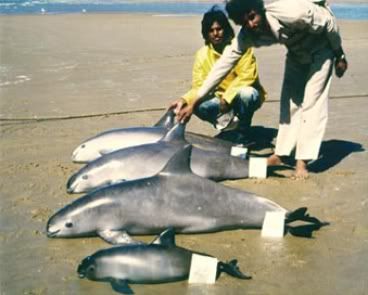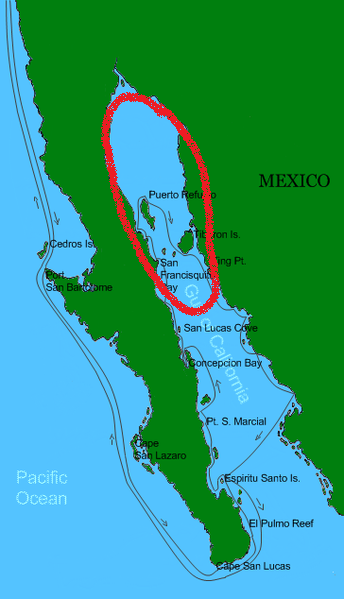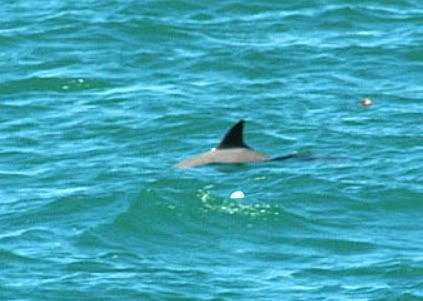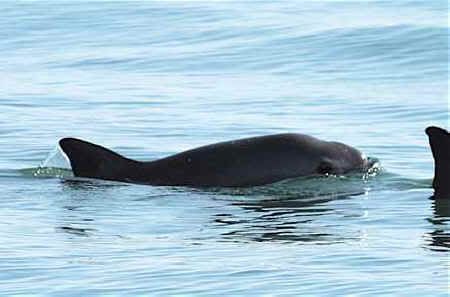Pompano
Elite Nomad
     
Posts: 8194
Registered: 11-14-2004
Location: Bay of Conception and Up North
Member Is Offline
Mood: Optimistic
|
|
RAREST AND MOST ENDANGERED PORPOISE
BAJA'S VAQUITA MARINA PORPOISE - ENDANGERED
The Sea of Cortez (Gulf of California) is home to the smallest..and most severely endangered
....porpoise.

Have you ever seen a Vaquita Marina? Probably not, unless you were very lucky or aboard a commercial fishing boat in the northern SOC.
There are less than 200 left..and that figure is dropping rapidly towards complete extinction.

THE VAQUITA MARINA PORPOISE:


Habitat - A Small Neighborhood
The vaquita is the rarest species of porpoise. It is endemic to the northern part of the Gulf of California (Sea of Cortez). There have been
just 65 confirmed sightings of live vaquita ever. Estimates of the number of individuals alive range from 100 to 200. Little is known about
the natural history of this rare porpoise. The silty waters of its home at the mouth of the Colorado River are almost always turbid, making
observation difficult. The word "vaquita" is Spanish for little cow., but some locals call it 'Cochito.'
Physical Description

Size comparison of vaquita to human.
The Vaquita has a classic porpoise shape, stocky and curved. It's the tiny one of the porpoises and thus amongst the smallest of all cetaceans. It
may grow up to 5 feet in length and weigh up to about 110 pounds. They have large black eye rings and lip patches. The upper side of the body is
medium to dark grey. The underside is off-white to light grey but the demarcation between the sides is indistinct. The flippers are proportionately
larger than in other porpoise and the fin is taller and more falcate. The skull is smaller and the rostrum is shorter and broader than in other
members of the genus.

Habitat
The vaquita lives in shallow, murky lagoons along the shoreline and is rarely seen in water much deeper than 30 meters; indeed, it can survive in
lagoons so shallow that its back protrudes above the surface. Other characteristics of its habitat are strong tidal mixing, convection processes and
high primary and secondary productivity.
Behavior

As I said before, there are very few records of the Vaquita in the wild. It appears to swim and feed in a leisurely manner, but is elusive and will
avoid boats of any kind. In over 35 years of prowling virtually all the waters of the Sea of Cortez, I cannot truthfully say I ever saw one...and even
if I did, I would not have known it was a rare Vaquita Marina.
Those that know say it rises to breathe with a slow, forward-rolling movement that barely disturbs the surface of the water, and then disappears
quickly, often for a long time. It has an indistinct blow, but makes a loud, sharp, puffing sound reminiscent of the Harbour Porpoise.
This is disturbing and tells a sad story: On occasion it has been reported that the Vaquita has turned hostile towards humans and
sometimes has been known to attack with brutality; using it's hard skull as a weapon.
Most of what scientists know about vaquita is based on dead specimens. The vaquita's diet-based on the stomach contents of one specimen-likely
consists of grunt, Gulf croakers, and squid. Like other phocoenids, the Vaquita occurs singly or in small groups, usually from 1 - 3 individuals but
as many as 8 - 10. Most calving apparently occurs in the spring. Gestation is probably 10-11 months. Maximum observed life span was 21 years.
The vaquita is one of the world's most endangered cetaceans.
Its tiny, isolated population makes it highly vulnerable to human activities.
Vaquita often are caught in nets set to catch other animals. This "incidental take" is the primary reason for the vaquita's endangered status. Gulf of
California fisheries include shrimp trawling and gillnetting. Each year, 25-30 vaquita drown in gillnets. At that alarming rate, the species will
be extinct shortly...
Vaquita survival is closely related to one gillnet fishery in particular: totoaba, a huge fish much like a white seabass. Like the
vaquita, the totoaba lives only in the upper Gulf. Vaquita are easily entangled in the larger holes of the totoaba nets. In 1990, the International
Whaling Commission (IWC) determined that the totoaba fishery is responsible for the vaquita's endangered status.
Totoaba is itself an endangered species. It's no surprise that for many years, totoaba fishing continued with no controls. Even
small-scale totoaba fishing was very difficult to monitor. Mexico banned totoaba fishing in 1975. The U.S. has banned imports of totoaba since 1977.
But demand for totoaba as a food fish keeps the illegal fishery profitable.
Laws in both the United States and Mexico protect the vaquita. It was placed on Mexico's endangered species list in 1978. The U.S. added the
vaquita to its endangered species list in 1985. A vaquita sanctuary was established in the northern Gulf area.
But as long as illegal totoaba fishing continues, vaquitas will continue to drown in gillnets. If people continue to buy totoaba, not only will
this fish become extinct, so will the vaquita.
NEED TO CONTACT SOMEONE ABOUT THIS?
If anyone cares to write a letter commending...or complaining..about the vaquita's situation, here's the official to send it to:
Juan Rafael Elvira Quesada
Secretariat of the Environment and Natural Resources
c.secretario@semarnat.gob.mx
Here's a sample of a letter:
Dear Sr. Jaun Elvira Quesada:
Thank you for your leadership and your commitment to protecting the vaquita marina porpoise, the world's most endangered small marine mammal that is
found only in the Upper Gulf of California, Mexico.
I applaud the recent decision of the Ministry of Environment to put the area designated as a refuge for the vaquita off-limits to all fishing, and to
limit shrimp trawling activities and bycatch throughout the entire Upper Gulf Biosphere Reserve. I encourage you to closely monitor and enforce your
landmark resolution to ensure the utmost protection for the vaquita and the Upper Gulf ecosystem.
I will continue to support the efforts of your government to remove harmful gillnets from all vaquita habitat and to provide safer alternatives to
local artisan fishermen so that we can ensure the long-term survival of this rare species.
Thank you for everything you do for animals!
Sincerely,
[Your Name]
[Your Address]
[City, State ZIP
You could also sign the following petition which always helps some, but writing a letter to me is always first priority and gets the most attention.
Sign an online petition here:
https://secure.nrdconline.org/site/Advocacy?cmd=display&...
Note: I hope I got that copied right...not too good at that, so if not email or U2U me and I'll get it right to you.

.
Let's hope our great-grandchildren can see and enjoy these magnificent creatures of the Sea of Cortez.
I do what the voices in my tackle box tell me.
|
|
|
David K
Honored Nomad
        
Posts: 65352
Registered: 8-30-2002
Location: San Diego County
Member Is Offline
Mood: Have Baja Fever
|
|
Thanks Roger!
|
|
|
Ken Bondy
Ultra Nomad
    
Posts: 3326
Registered: 12-13-2002
Member Is Offline
Mood: Mellow
|
|
Thanks Roger. Just sent my letter to Sr. Quesada. ++Ken++
carpe diem!
|
|
|
Skeet/Loreto
Ultra Nomad
    
Posts: 4709
Registered: 9-2-2003
Member Is Offline
|
|
Thanks Roger: I have heard of but never seen one of these .
It seems to me that they may be surviving and we only see them when the Commercial catch one or Two.
I would hope the can contuine to Hide and survive. It would be very difficult to prevent a Commercial from getting one in his nets as he cannot see
them.
Have to stop all commercial fishiong and that is just not going to Happen.
May be better for his kids to eat and let his Grandchildren do their own thing.
Skeet
|
|
|
ELINVESTIG8R
Select Nomad
      
Posts: 15882
Registered: 11-20-2007
Location: Southern California
Member Is Offline
|
|
Oh, Oh Look Who Is Back!

[Edited on 1-1-2010 by BajaNomad]
|
|
|
|

